February 28, 2006
TECHNOS QUARTERLY Fall 1996 Vol. 5 No. 3
Illumination in the Desert
By Kenneth Goodall
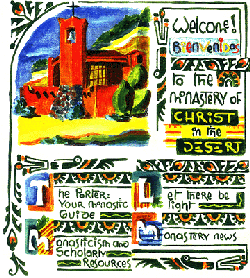 As
long ago as the sixth century, monks have used illumination to turn information
into beautiful works of art. Now those same skills and dedication—combined
with cyberspace savvy—are lighting up the World Wide Web, from New Mexico
to the Vatican. And suddenly an ancient art again opens doors (and Windows™)
for a whole new generation of learners.
As
long ago as the sixth century, monks have used illumination to turn information
into beautiful works of art. Now those same skills and dedication—combined
with cyberspace savvy—are lighting up the World Wide Web, from New Mexico
to the Vatican. And suddenly an ancient art again opens doors (and Windows™)
for a whole new generation of learners.
Monks at Christ in the Desert monastery near Abiquiu in northwestern New Mexico, faced with a need for income to support their growing community, turned to what monks have always done best: the art of illumination. But instead of illuminating parchment or paper manuscripts, as their fellow Roman Catholic religious did in the Middle Ages, they are lighting up cyberspace.“In the scriptorium of Christ in the Desert monastery, we don't have any parchment (well, maybe a little), and even paper is used sparingly,” computer-bound visitors to the monastery's virtual site are told.“We write on electrons, creating cyberbooks: pages for the World Wide Web.”
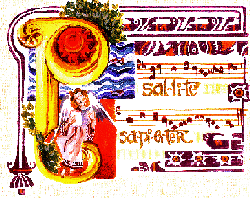 Founded
in 1964, the monastery, an adobe building housing 24 monks along with 12 personal
computers run by an array of solar panels, sits 75 miles northwest of Santa
Fe on the Rio Chama in the Sangre de Cristo Mountains. The area is known for
such great Southwest artists as Georgia O'Keeffe.
Founded
in 1964, the monastery, an adobe building housing 24 monks along with 12 personal
computers run by an array of solar panels, sits 75 miles northwest of Santa
Fe on the Rio Chama in the Sangre de Cristo Mountains. The area is known for
such great Southwest artists as Georgia O'Keeffe.
Major Publishing Project
Now the Benedictines' desert art is attracting worldwide attention: the Vatican just signed up “scriptorium@christdesert” (registered trademark of the monastery's Web design business) to produce the Holy See's Web pages.“It's easily one of the largest publishing projects ever undertaken in any medium,” 30-year-old Brother Mary-Aquinas told TECHNOS. “We have full responsibility for the design of the Vatican's Web site, including visual/artistic design, content organization, and the underlying technical design.” A former systems analyst in Denver, Brother Aquinas is the director of Christ in the Desert's scriptorium and also director of the massive Vatican Project.
Complete Vatican Offerings
Included in the Vatican's Web pages, Brother Aquinas said, will be tens of thousands of documents and books—each of which will be entered in as many as a dozen languages—along with complete collections from the Vatican museums and libraries. A Vatican news service will integrate words, audio, and video, and there will be sections for children and families and for such special events as World Youth Day and Millennium 2000. “Very many other things as well!” Brother Aquinas added, his excitement apparent.
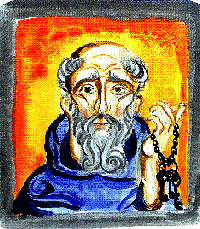 Christ
in the Desert's own Web pages are truly unique. “At least one organization
listed our Web site as ideal for teachers to use to introduce students to
the Web,” Brother Aquinas noted. Welcomed and guided by Brother URL (the
acronym for “universal resource locator,” which refers to addresses
on the Web), visitors to the site find artwork that spices age-old illumination
techniques with a strong Southwest flavoring. Monks, working at rough tables
that line the scriptorium's packed-dirt floors, do the hand lettering on canvas
and scan the illuminations (using a Microtek scanner) into their computers,
then incorporate them into the Web pages.
Christ
in the Desert's own Web pages are truly unique. “At least one organization
listed our Web site as ideal for teachers to use to introduce students to
the Web,” Brother Aquinas noted. Welcomed and guided by Brother URL (the
acronym for “universal resource locator,” which refers to addresses
on the Web), visitors to the site find artwork that spices age-old illumination
techniques with a strong Southwest flavoring. Monks, working at rough tables
that line the scriptorium's packed-dirt floors, do the hand lettering on canvas
and scan the illuminations (using a Microtek scanner) into their computers,
then incorporate them into the Web pages.
Information into Art
“I can't think of better work for us to be doing,” Brother Aquinas told a visiting New York Times reporter last March. “This work goes back to the ancient tradition of the scribes, taking information and making it beautiful, into art.” For centuries during the Middle Ages, monasteries throughout Europe and the British Isles maintained scriptoria where monks produced handwritten and hand illuminated manuscripts. Such work became almost obsolete, however, with the advent of printing in the 15th century. “In a certain sense, the Web and what will happen in the next decade is a return to that tradition,” Brother Aquinas said. The Times reporter noted that a wooden crucifix hangs on one wall of the scriptorium and “hand-painted illuminations by the monks share shelf space with Windows 95, Adobe Illustrator, and Partition Magic.”
The cyberspace operation at Christ in the Desert is part of a trend noted in a recent article in Wired magazine (Heather Millar, “The Electronic Scriptorium,” August 1996). “In growing numbers,” Millar writes, “religious orders across the country have taken on…computer work as a replacement for more traditional occupations like distilling brandy or making cheese.” Monks and nuns are helping turn university library card catalogs into digital systems, cataloging archives for such enterprises as the New York Daily News and Time magazine, and digitizing records for government agencies.
CID Web Pages
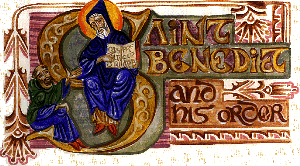 The
Christ in the Desert Web pages provide informative texts as well as beautiful
illustrations. Web pages include an introduction (“scriptorium@christdesert”),
a history of the Benedictines, “A Brief History of Scriptoria and the
Evolution of the Book,” “Monasticism and Scholarly Resources,”
a gift shop guide that features the monks' handicrafts, and information for
guests who want to visit and stay in the monastery's guest house. (A minimum
stay is two nights; maximum two weeks. Reservation materials are provided
by e-mail.) Wordsmiths will enjoy the beautifully illustrated definitions
(such as scribe, rubricator, and miniator).
The
Christ in the Desert Web pages provide informative texts as well as beautiful
illustrations. Web pages include an introduction (“scriptorium@christdesert”),
a history of the Benedictines, “A Brief History of Scriptoria and the
Evolution of the Book,” “Monasticism and Scholarly Resources,”
a gift shop guide that features the monks' handicrafts, and information for
guests who want to visit and stay in the monastery's guest house. (A minimum
stay is two nights; maximum two weeks. Reservation materials are provided
by e-mail.) Wordsmiths will enjoy the beautifully illustrated definitions
(such as scribe, rubricator, and miniator).
An online catalog of books that may be purchased at the monastery's bookstore features works by fellow monk Thomas Merton. Merton, who stayed at the monastery in 1968 after leaving his Trappest monastery in Kentucky in search of “a new place,” wrote Woods, Shore, and Desert while there. The book includes photographs that he took of the monastery and surrounding area, including one of Merton with Georgia O'Keefe. [Shortly after leaving the New Mexico monastery, Merton died tragically in December 1968 in Bangkok, Thailand, while attending a congress of monks.]
Another Web page included, until the Vatican project came along, was an advertisement for a business the monks had planned: helping others, including schools, foundations, and corporations, design their own Web pages. Brother Aquinas was swamped with requests for help, particularly after the Times ran an article on the scriptorium on Sunday, March 17, 1996. “Unfortunately, because the Vatican project is so large, we aren't able to work with other clients any longer,” Brother Aquinas told TECHNOS.
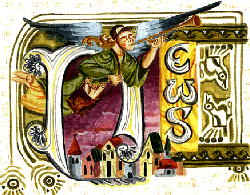 He
pointed out, however, that the monastery's Web pages have proved interesting
not only to schoolchildren wanting to start their own Web pages but also to
those studying medieval European history, “since they are able to see
that monks are still very much alive in the current age.” And, he said,
“the Vatican site will have significant educational value, especially
as we bring the libraries, museums, and architecture of the Vatican online.
We definitely want to provide specialized tours and sections that will make
the resources appealing to different age groups.”
He
pointed out, however, that the monastery's Web pages have proved interesting
not only to schoolchildren wanting to start their own Web pages but also to
those studying medieval European history, “since they are able to see
that monks are still very much alive in the current age.” And, he said,
“the Vatican site will have significant educational value, especially
as we bring the libraries, museums, and architecture of the Vatican online.
We definitely want to provide specialized tours and sections that will make
the resources appealing to different age groups.”
Speaking generally, Brother Aquinas thinks that the Web “will certainly impact education because of the immediate access to information it is fast beginning to provide.” He also predicted that school intranets, because of their collaborative potential, may have an even more significant impact.
The talented Scriptorium director sees great potential for the Web in education, and observed that “the coming ubiquity of network-published teaching materials will undoubtedly have a significant impact in the classroom.”
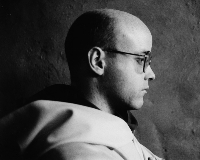 Brother
Mary-Aquinas is the director of Christ in the Desert's scriptorium and Vatican
project director. He is a former systems analyst from Denver.
Brother
Mary-Aquinas is the director of Christ in the Desert's scriptorium and Vatican
project director. He is a former systems analyst from Denver.
Brother Aquinas hopes that the monastery will be able to work with school districts in the future to develop collaborative intranets and fun, artistic sites that will appeal to kids.
For now, however, the monks at Christ in the Desert are focusing “very heavily” on the Vatican project. It's enough to keep 24 Benedictines busy—what with the cleaning, the chopping, the weaving, the carving, the baking, and all those other quotidian monastic duties.
Contact Brother URL at http://www.christdesert.org/pax.html.
Brother Mary-Aquinas' photo is courtesy of Tony O'Brien ©.
Kenneth Goodall is a freelance writer, editor, and philosopher who lives in bucolic Stinesville, Indiana. A former newspaper editor and senior editor of Psychology Today, he has worked in Miami, New York City, Washington, DC, and San Diego.
Each month we bring you an exciting new e-Zine from Technos Press! Read the February issue.
AIT digital content— indexed, searchable, and correlated to state standards—with flexible licensing options.
With The Learning Source you can find, preview, and use the right video when you want it.